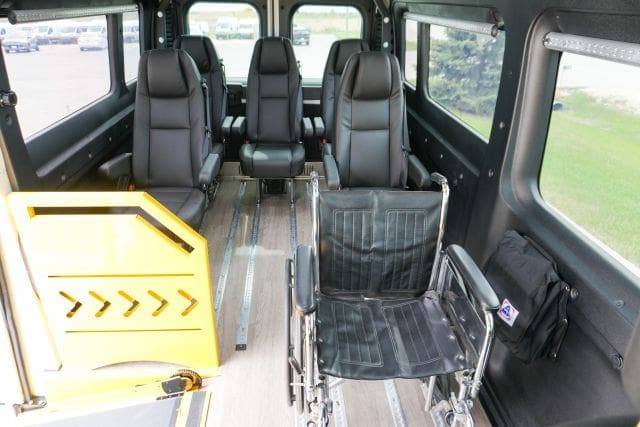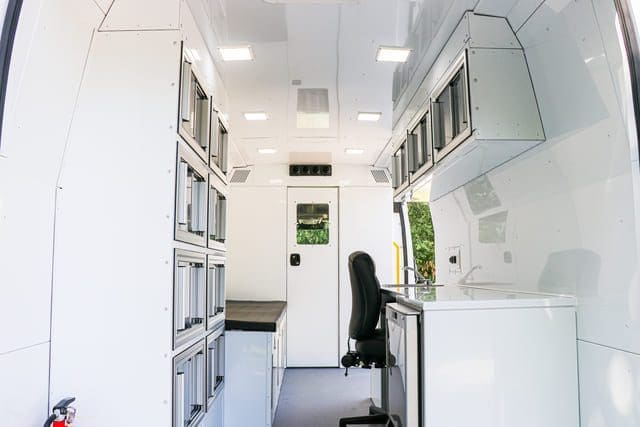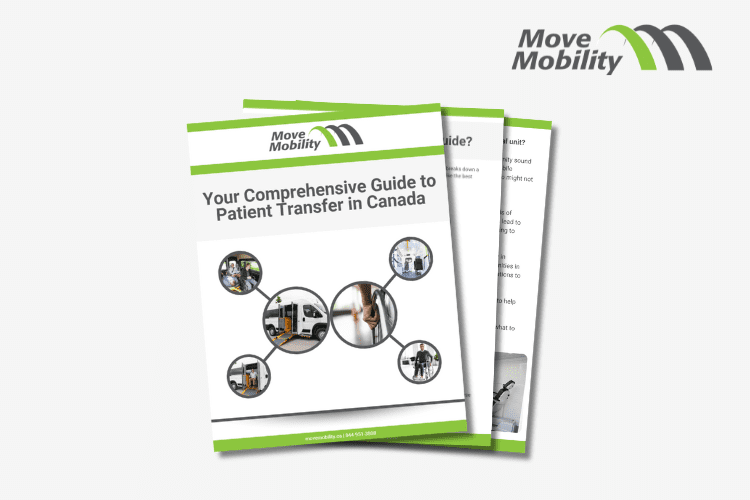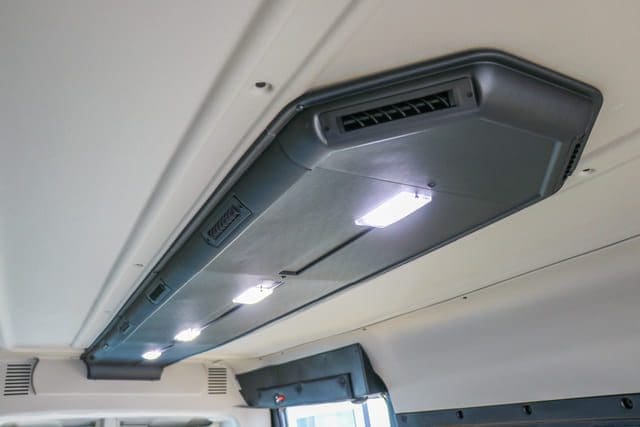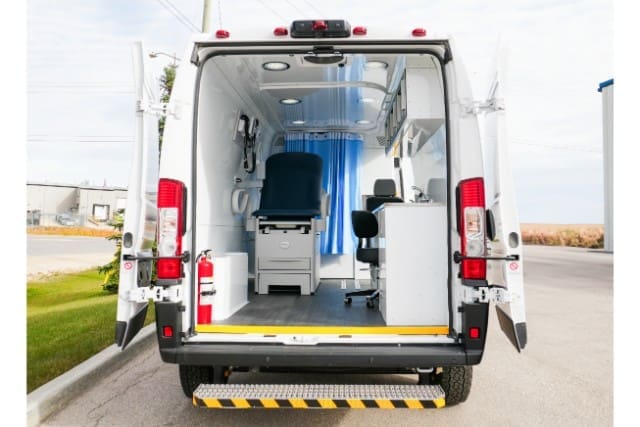Across Canada, many organizations like yours struggle to find the right vans for medical transportation. People count on you to get them to appointments, dialysis, or community care. But old vans, repairs that never seem to end, or layouts that don’t fit your riders make things stressful.
When patients miss care:
- Their health suffers
- Staff and family members feel drained
- Communities lose trust
That gap can feel heavy. Now imagine having safe, reliable vans that fit your needs, cut down stress, and give people comfort and dignity on the road. That kind of change can free up your team to focus on what matters most: Caring for people.
At MoveMobility, we’ve been building vehicles for over 20 years. Our vans carry Ford QVM and Stellantis QPro certifications and the National Safety Mark, which means they meet strict safety rules. Organizations like Quest Community Health Centre trust us because we listen first and design around their goals. While we’re proud of what we build, we know we aren’t the only option, so this article will give you open and useful information.
Today, you’ll learn about the top three wheelchair vans for medical transportation, including:
- P4 Wheelchair Van: Flexible seating and accessibility
- P4 3-in-1 Van: Multi-use design for transport needs
- Dialysis Patient Transport Van: Comfort for frequent trips
1. What is the P4 Wheelchair Van?
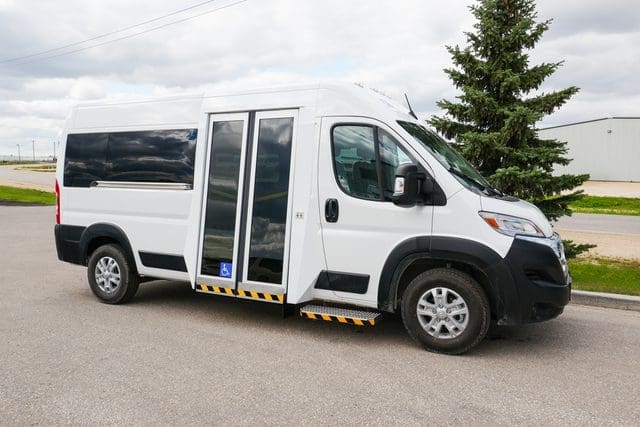
When it comes to medical transportation in Canada, the P4 Wheelchair Van stands out as one of the top choices. Health programs, senior centers, Indigenous, and community organizations often look for a van that’s big enough to serve multiple needs, but small enough to handle busy city streets or rural roads throughout the year. The P4 strikes that balance, making it a go-to for groups that want flexibility without the size and cost of a bus.
Flexible seating makes planning simple
The P4 can carry up to 10 ambulatory passengers, 3 wheelchairs, or a mix of both. This makes it perfect for organizations that never know who will need a ride on a given day. For example, a health center in Winnipeg may need to bring five seniors to a medical appointment one day, then transport two wheelchair users and family members the next. Instead of running multiple vehicles, one P4 can adapt to both.
One entrance for everyone
Unlike large cut-away buses that separate wheelchair users from other riders, the P4 keeps everyone together. The side entry ramp allows all passengers, including ambulatory and wheelchair users, to board through the same door. That small detail makes a big difference in how people feel. A wheelchair user heading to dialysis in Toronto doesn’t need to wait outside while a lift lowers them down. Instead, they roll right in alongside everyone else. It’s faster, safer, and gives people dignity in the process.
Designed for Canadian roads and weather
Canada’s winters can be brutal. The P4’s front-wheel drive provides strong traction on snow and ice, and its high ground clearance helps with icy curbs or uneven parking lots. Communities in Northern Ontario or the Prairies don’t need to worry about a lowered floor scraping over snowbanks. And with a fuel mileage of 21 mpg, the P4 helps stretch limited budgets, especially for non-profits running daily non-emergency medical transportation services.
Safety and inclusion built in
Safety matters most in medical transport services.
The P4 includes:
- Heavy-duty ramp: Supports up to 1,000 lbs with smooth, quiet operation.
- CMVSS & D409 Certification: Meets strict Canadian safety standards.
- Secure restraints: 4-point wheelchair restraints with lap and shoulder belts.
- Backup systems: Manual options for doors and ramps if power ever fails.
These features reduce the stress of transport, both for staff and passengers. A driver in Halifax doesn’t have to worry about a ramp failing, and families can feel confident their loved ones are safe during every ride.
Easy to operate
The P4 doesn’t require any special driver licensing, making it easier for community groups and healthcare programs to recruit staff or volunteers. Backup cameras and outward-opening glass doors give drivers confidence when navigating tight hospital parking lots or busy downtown curbs.
Why it works for medical transportation
The P4 isn’t oversized like a bus, but it still carries a lot of people. It makes loading and unloading fast, keeps everyone included, and can handle Canada’s unique climate. For organizations looking to downsize from a bus while still providing reliable non-emergency medical transportation, the P4 offers a practical and dignified solution.
2. What is the P4 3-in-1 Van?
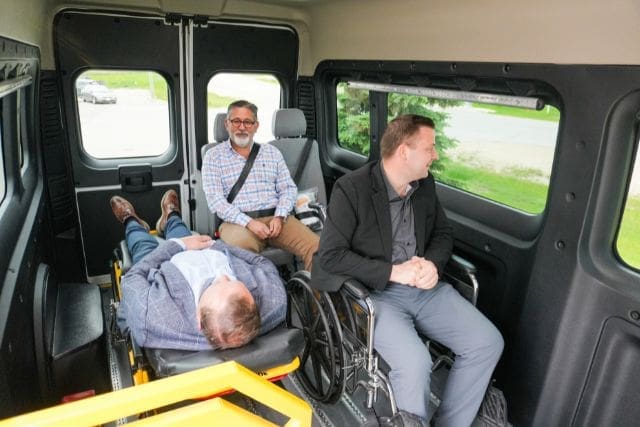
When your program needs to move people with different mobility needs, one-size-fits-all vehicles rarely do the job. That’s where the P4 3-in-1 Van comes in. Built on the Ram Promaster 2500 High Roof, this van is designed to carry wheelchair users, stretcher patients, and ambulatory riders, all in the same trip. For medical transportation providers across Canada, that flexibility makes it a top choice.
Three ways to transport, one vehicle
The standout feature of the P4 3-in-1 Van is right in its name. It can handle three types of passengers at once. For example, a patient transfer service in Edmonton could use the van to bring one person on a stretcher from the hospital to long-term care, while also transporting two wheelchair users and family members in the same ride. This saves organizations from needing multiple vehicles and makes scheduling much simpler.
Safety for every passenger
Medical transport services can’t compromise on safety.
The P4 3-in-1 includes:
- 4-point wheelchair restraint kits: Keep wheelchair users secure with lap and shoulder belts.
- Antler stretcher securement system: Locks stretchers in place during transport.
- CMVSS & D409 Certification: Meets strict Canadian vehicle safety standards.
Knowing these systems are built in gives staff peace of mind and helps patients feel more comfortable during rides.
Smart ramp design
The heavy-duty side entry ramp can carry up to 1,000 lbs and folds neatly away without blocking the door. That means ambulatory passengers can still use the same entrance without waiting for the ramp to move. It also creates a barrier-free entry, making it easier for people with limited mobility to step in. Imagine pulling up to a snowy curb in Saskatoon. Drivers can deploy the ramp right to the drop-off area, cutting down on slips and stress.
AutoFloor for fast changes
Every day brings a different mix of riders. That’s why the P4 3-in-1 comes with AutoFloor, a flexible seating and floor track system. Need more stretcher space today, but more wheelchair spots tomorrow? AutoFloor lets you reconfigure quickly, so you don’t waste time swapping vehicles or turning away riders. It’s one van that adapts to your program, not the other way around.
Built for Canadian conditions
From icy driveways in Halifax to summer heat in Vancouver, the P4 3-in-1 is designed with Canada in mind.
Features include:
- Front wheel drive and high ground clearance: Reliable in snow and rough roads.
- Efficient heating and cooling: Keeps patients comfortable in every season.
- Large windows with privacy protection: Natural light without sacrificing comfort.
- Anti-slip running boards and grab handles: Safer entry and exit for drivers and passengers.
Why it works for medical transportation
The P4 3-in-1 gives providers the ability to handle almost any rider need with one vehicle. That means fewer scheduling headaches, more efficient use of resources, and better experiences for patients. For Canadian organizations delivering non-emergency medical transportation services, the P4 3-in-1 Van is a practical and adaptable choice that supports dignity and safety for everyone on board.
3. What is the Dialysis Patient Transport Van?
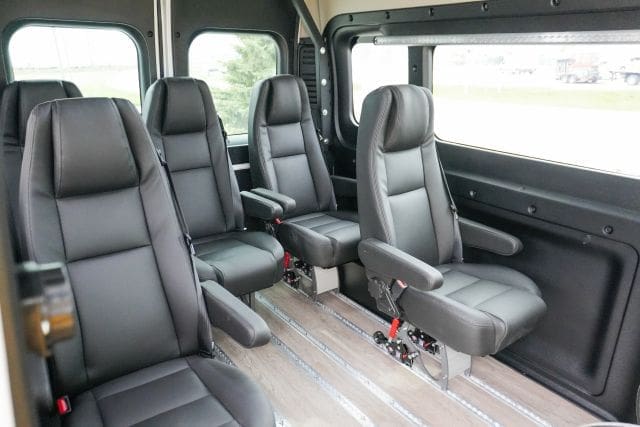
For many Canadians, dialysis is not just a treatment; it’s a routine. Patients often travel three or more times a week, sometimes long distances, and those trips can feel exhausting. That’s why the Dialysis Patient Transport Van was designed with comfort, dignity, and safety in mind.
Comfort that makes a difference
Dialysis patients are often tired before they even begin their trip home. The van’s large reclining seats give them space to stretch out and rest. A senior travelling from a rural Manitoba town to Winnipeg for dialysis can lean back, relax, and feel supported after treatment.
The dual heating system ensures the whole van stays warm, especially around the feet, which is a common comfort issue in Canadian winters. No more shivering through long rides in minus 30.
A calming, supportive space
The van includes features that help riders feel at ease:
- Privacy blinds for a calm, respectful environment.
- Wi-Fi and USB charging ports so patients can stay connected with family or stream something to pass the time.
- A relaxing sound system to reduce stress and create a soothing space.
These touches may seem small, but for someone traveling hours each week, they turn a stressful journey into a more manageable one.
Accessibility for every rider
Not every dialysis patient is ambulatory. Some use wheelchairs, and this van makes sure they’re included, too. The powered side-entry ramp is smooth, quiet, and supports up to 1,000 lbs. When stowed, it doesn’t block the doorway, so ambulatory passengers can step in easily.
Bus-style glass doors improve visibility for drivers and give patients a clear view outside, while external switches make operating the doors and ramp simple from outside the van.
The AutoFloor system makes it easy to adjust layouts for wheelchairs or seats depending on the day. Whether the van needs to carry three wheelchairs, a mix of ambulatory passengers, or a combination, staff can reconfigure the space quickly.
Safety and peace of mind
Dialysis patients and their families need to know every ride is secure.
This van comes equipped with:
- 4-point wheelchair restraints with lap and shoulder belts.
- CMVSS-tested systems that meet Canadian safety standards.
- Manual backup systems for ramps and doors, ensuring access even in power outages.
Why does it work so well for dialysis transportation?
The Dialysis Patient Transport Van focuses on three things:
- Care
- Relief
- Respect
It supports patients physically with comfortable seating and heating, mentally with calming features, and practically with accessibility and safety systems.
For healthcare teams across Canada, this van helps transform routine dialysis trips into supportive journeys, where patients feel valued and cared for, not just transported.
Ready to move forward with a wheelchair van for medical transportation?
You came here because your organization faces a tough challenge: finding safe, reliable, and dignified transportation for patients and mobility riders. That challenge can feel overwhelming when you’re working with outdated vehicles or limited options.
Here’s what you learned today:
- P4 Wheelchair Van: A flexible, compact solution for city routes.
- P4 3-in-1 Van: Adaptable for wheelchairs, stretchers, and walk-on riders.
- Dialysis Transport Van: Designed for patient comfort during routine medical trips.
At MoveMobility, we’ve been building medical and wheelchair accessible vans that Canadians trust for two decades. Our team designs each vehicle with healthcare providers in mind, blending innovation with real-world experience. We deliver solutions that improve lives and ease the burden on local health teams. Our goal is simple: To make healthcare and mobility more accessible across Canada. If you have questions, click the button below to talk to a mobility expert. We’d love to help.
If you’re not ready to talk to a mobility expert yet, here are a few resources to explore next:
- How to choose a wheelchair van: A step-by-step guide that builds on what you learned today and helps narrow down the right vehicle for your program.
- Rear entry vs. side entry full size wheelchair vans (pros & cons): Understand which entry style matches your routes and patient needs.
- Delivering wheelchair vans to remote locations in Canada: What it Looks Like with MoveMobility: See how we support communities outside big cities, which may be similar to your service area.


